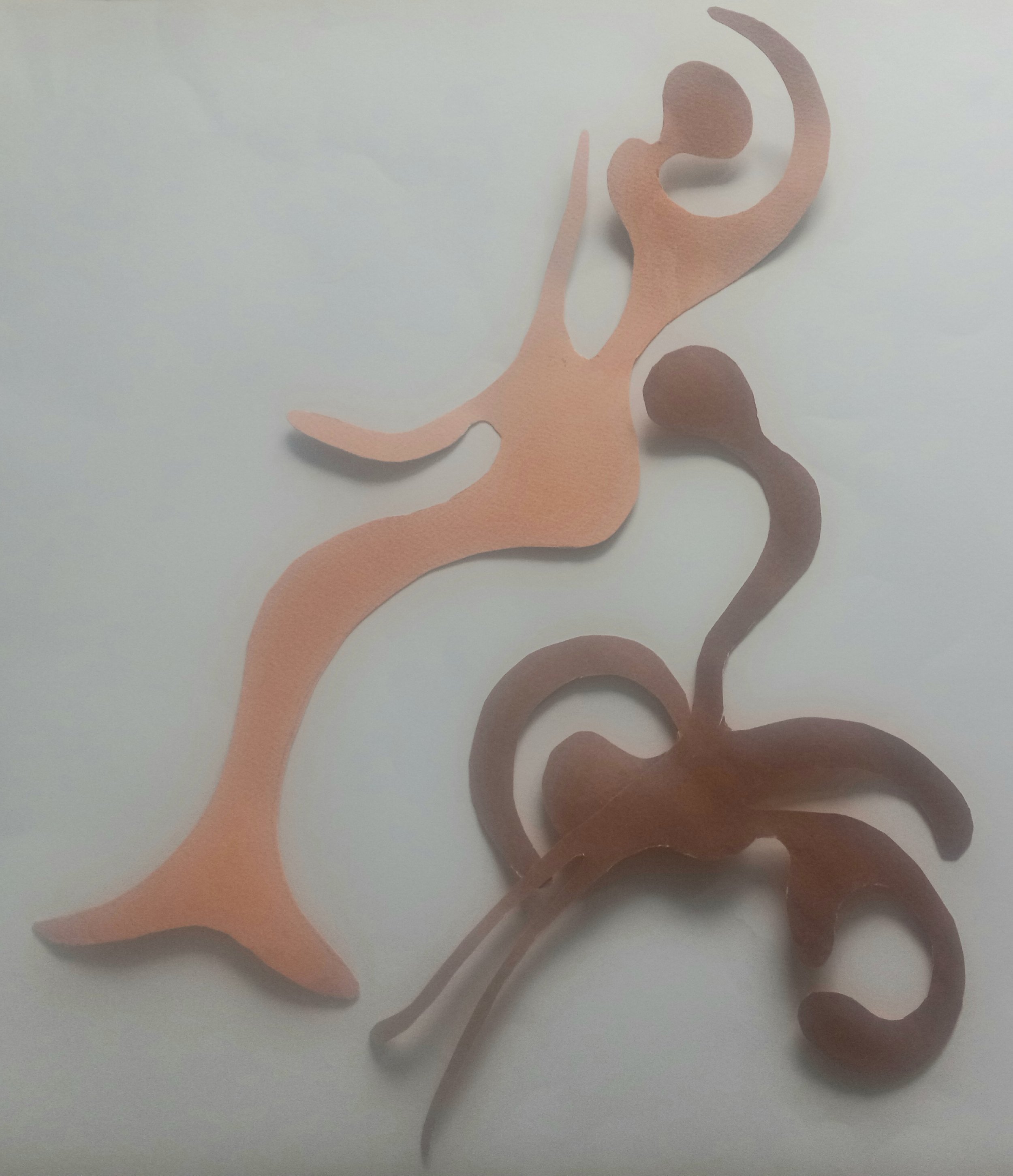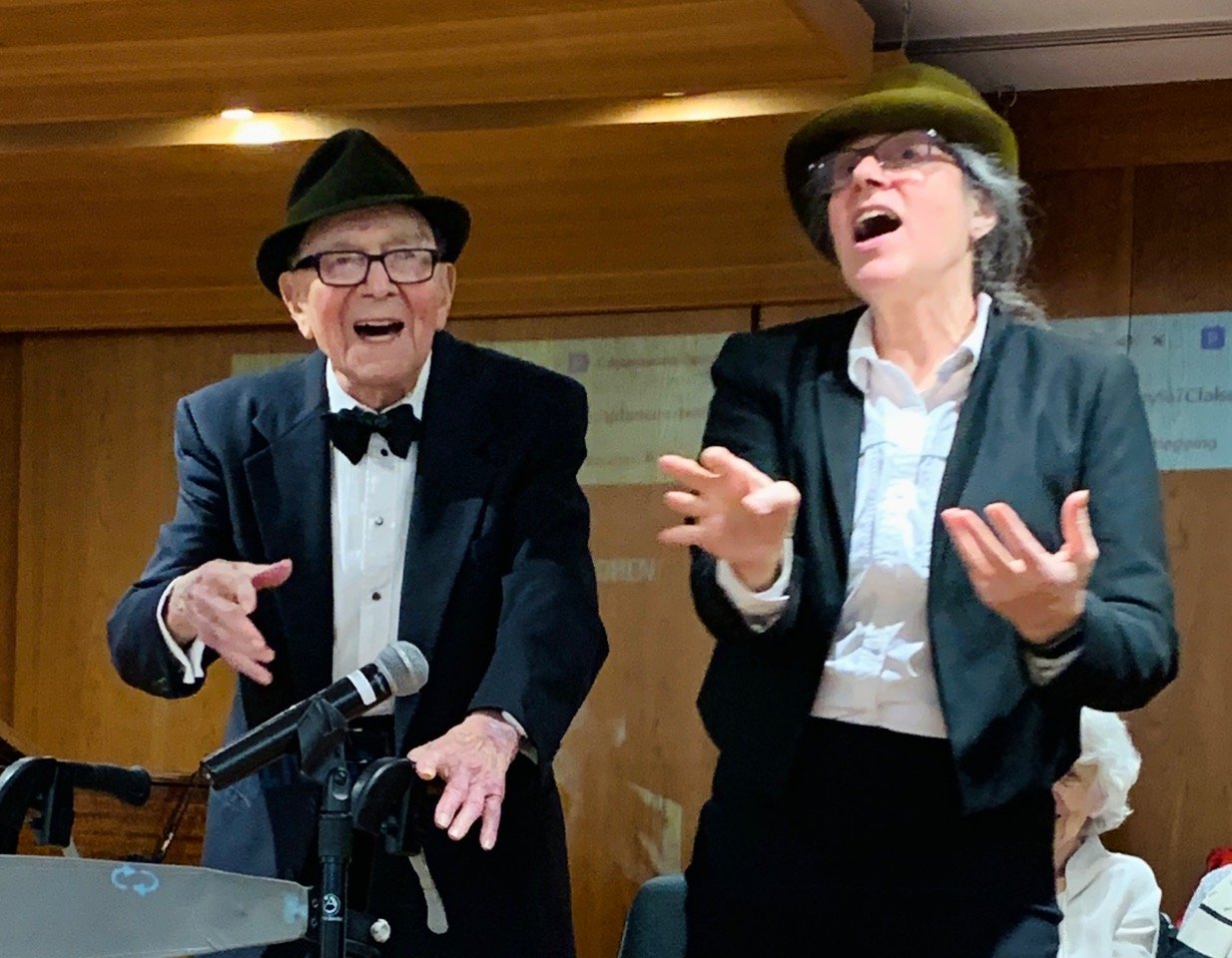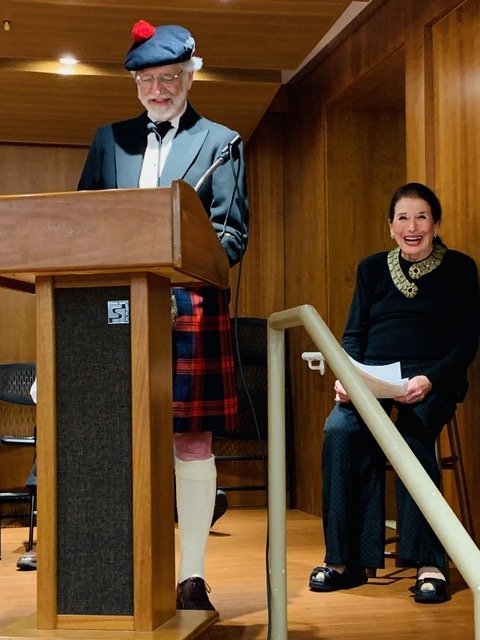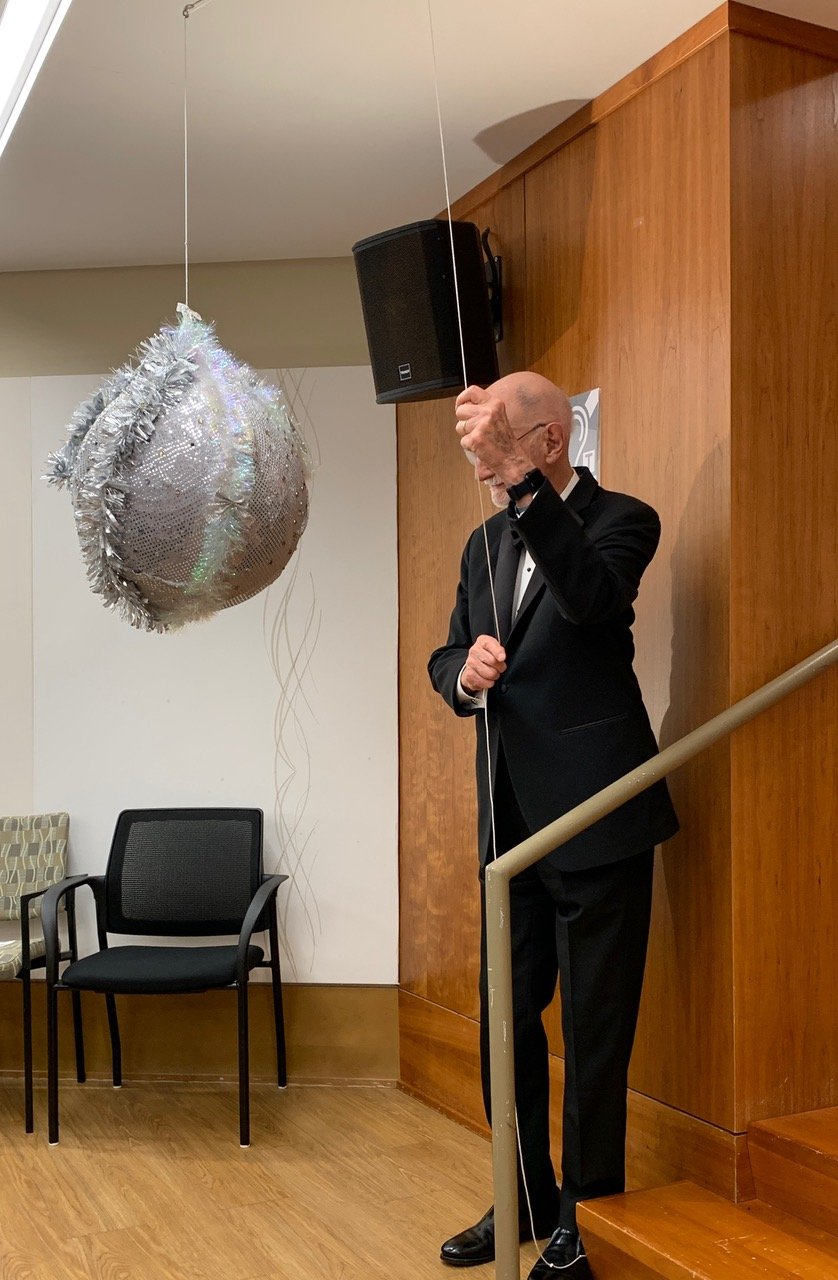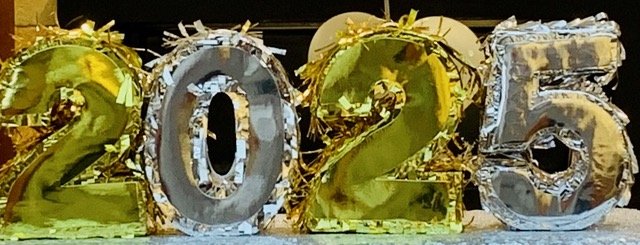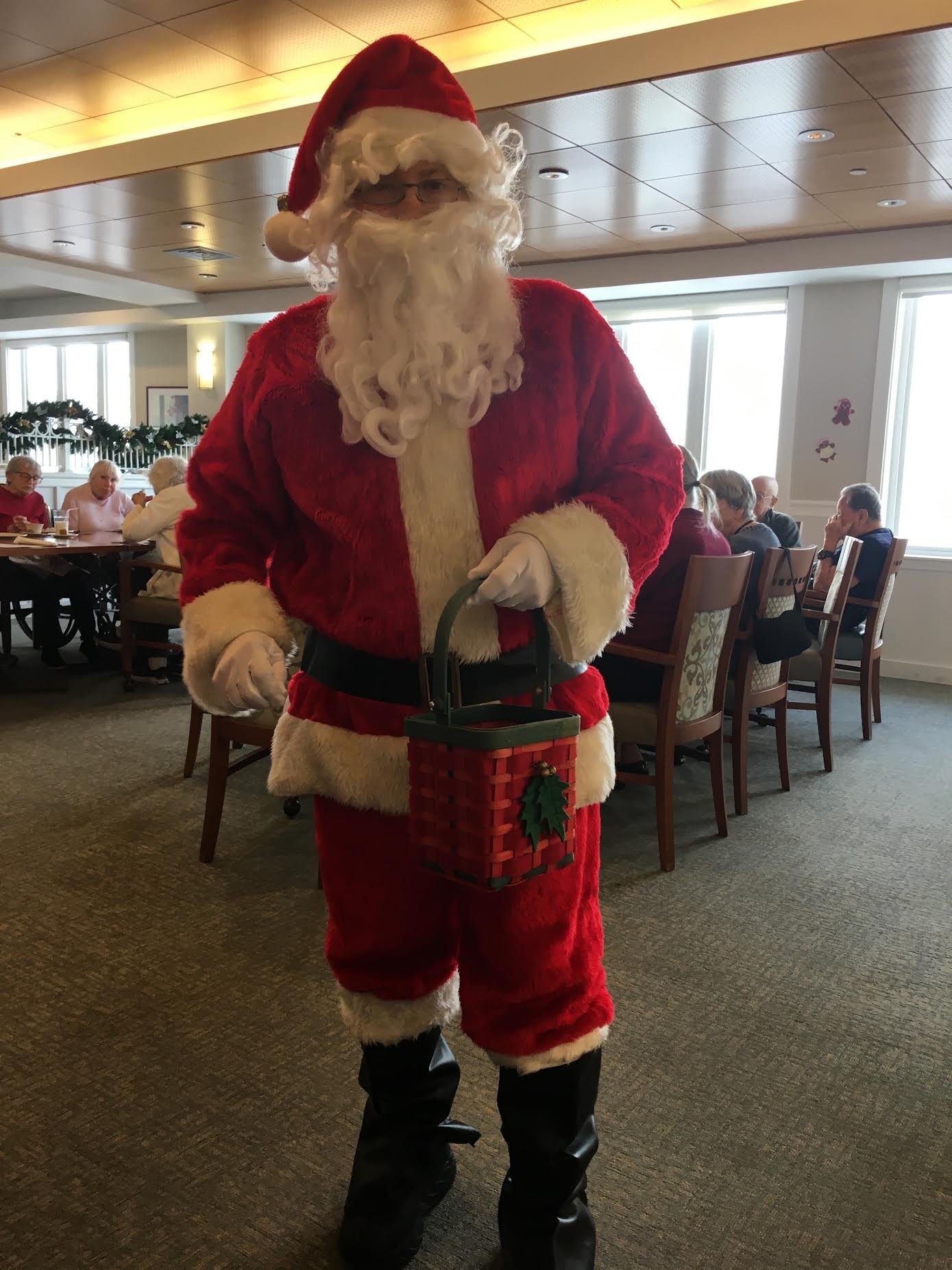Drawing with Scissors IV, by Sheila Benedis
Art and photos by Sheila Benedis
Art by Hart
Spike and his buddies enjoyed Saturday morning meet-ups in the pond
Try as he might, Haden couldn’t grow a mustache
Oh crumb! Little Oswald would be late for his anger management class
Russell was pretty sure the large pink animal story was a myth
Dunster’s scale was lying again
Art and photos by Jane Hart
In and Around Kendal
Kendal Skies from Dawn to Dusk
The Break of Dawn Photo by Philip Monteleoni
Early Morning Photo by Coco Eiseman
Photo by Carolyn Reiss
Photo by Carolyn Reiss
Western Skies Aflame Photo by Edward Kasinec
New Year's Eve: Kendal Style
It’s fun. It’s silly. It’s delicious. It’s Kendal New Year’s Eve! As a community, we pitch in to organize, decorate, entertain, laugh, applaud, and . . . well . . . enjoy!
As photographs of the Great Event roll in, we include them. Those that follow here are all from 2 Kendal doyens of photography: Harry Bloomfeld and Carolyn Reiss.
(Keep those pictures coming in Kendal photographers! Don’t be shy.)
New Year’s Eve Prep
Photos by Harry Bloomfeld
The Program
Ode to Ellen Photo by Harry Bloomfeld
Bob Newhart aka Greg Lozier Photo by Carolyn Reiss
A New Year’s Tradition: One Liners By Harry Bloomfeld
Moments of Calm and Beauty Photo by Harry Bloomfeld
Leonard Cohen Was There! (aka Bill Rakower — and daughter) Photo by Harry Bloomfeld
Gaudeamus Kendal Photo by Harry Bloomfeld
Highland Humor Photo by Harry Bloomfeld
Kendal Thespians in Action Photo by Carolyn Reiss
A Golden Act: The Goldenaires Photo by Harry Bloomfeld
And the Ball Begins Its Descent at Kendal Midnight Photo by Harry Bloomfeld
The Party
A Job Well Done — as Always
Photos by Harry Bloomfeld
Don't Forget to Remember
I Didn't Know That
Ancient Egyptians Shaved Their Eyebrows as a Sign of Mourning When Their Cats Died
Ancient Egyptians are often said to have worshipped cats. They didn’t — though it is accurate to say their felines were beloved and pampered, sometimes bedazzled in gold accessories, and occasionally allowed to eat directly from dinner plates at meals.
Cats first made their appearance in Fertile Crescent farming communities around 8,000 years ago, and they initially earned their keep as household protectors from rodents, snakes, and scorpions. Eventually, the Egyptians grew to see cats’ protectiveness and companionship as the same traits held by their deities, particularly Bastet, a goddess often depicted as a cat or lion who was honored with temples and pilgrimages. All in all, the Egyptians bonded so well with their cat companions that they mourned their pets after death, and both cat owners and family members would publicly express their grief by shaving off their eyebrows. Some historians believe that the mourning period lasted until a new set of eyebrows grew in (which could be as long as three or four months).
The ancient Egyptians are often credited with domesticating felines, though in 2004, archaeologists found a 9,500-year-old cat buried in Cyprus — suggesting cats may have been living alongside humans earlier than previously thought. Still, Egyptians likely helped transform cats from the tiny, wild creatures they once were to the lazy furballs we now snuggle with; some historians believe the Egyptians selectively bred housecats, helping their numbers flourish and giving them the temperaments we now enjoy (or at least tolerate) today.
Made In NYC: Brands, Trends, and Inventions That Began in the Big Apple
Pasta Primavera
Pasta primavera seems like a dish that goes back to old Italy, with a few centuries of tradition backing it. In fact, it’s a New York City creation. It hit the big time in a 1977 Times article that included the recipe. Prior to that, it was an unlisted special at an uptown French restaurant. (The chef-owner, Sirio Maccioni, was Italian at least.)
According to lore, the French chefs at Le Cirque refused to allow pasta to be served, so, to accommodate orders, a pasta pot had to be set up in the hallway and the dish finished by waitstaff in the dining room.
Puffed Rice
School bake sales would never be the same after December 1901. That’s when Botanist Alexander Pierce Anderson conducted a successful experiment in a laboratory at the New York Botanical Garden. As the garden explains, Anderson was confirming the theory that “a starch granule contains a minuscule amount of condensed water within its nucleus.” When the grains exploded and puffed up to 8 times their original size, Anderson knew the prediction was accurate (and that commercial applications would not be far away). Today, Rice Krispies alone sells over 40 million boxes a year.
Colorforms
Remembering this toy — proudly pre-screen — may date you, although it’s still going strong, complete with its own Netflix show. Colorforms were born more than 70 years ago in a Manhattan bathroom. (The adhesive quality of the glossy paint there was what made Harry and Patricia Kislevitz realize they were onto something.) It went on to licensing agreements with pop culture icons (Popeye was the first) and accolades like ranking among the Top 10 Toys of the Century by the Toy Industry of America (TIA).
Source: “Made In NYC,” by Ethan Wolff, March 2024, City Guide New York
Contributed by Bobbie Roggemann
For Your Funny Bone . . .
Art by Hart
Zelda knew all the clouds on a first-name basis
Nadelman didn’t know if it was his political insights or his political savvy that made him so popular
The 8th-grade science geeks used items from the lost-and-found to build a working spacecraft
This was the birthday Emmy would compute her age in dog years
A morning latte did wonders for Sadie’s knees
Art and photos by Jane Hart
Drawing with Scissors III, by Sheila Benedis
Art and photos by Sheila Benedis
In and Around at Kendal
Scenes of the Season, by Edward Kasinec
Stopping by the Woods on a Snowy Evening
Yuletide Snow
The Great Snow of 2024, by Carolyn Reiss
Left My Car Out Over Night
Photo by Jane Hart
He Came!
Proof Positive
Le Groupe Conversation Française fête Noël
And in the Category of Cute Couple…
Mimi and Bob Abramovitz at, uhm, Play
Photo (and nomination) by Willa Hallowell
Book It!
Here’s a new idea: what have you been reading that you would suggest to others? Valerie Wallace sent a recommendation for the new year. Here’s her brief review for Robert Harris’ Precipice:
I have just finished a fascinating novel called Precipice by Robert Harris which might interest other Kendal Readers. Here is my capsule review: Precipice by Robert Harris is a “take-your-breath-away” novel based on the correspondence of H. H. Asquith (the British PM at the start of WWI ) and his mistress. He had a very casual attitude about copies of Top Secret documents and government discussions about the conduct of the war. Spoiler alert to fans of W.Churchill: DO NOT READ THIS BOOK. Can you say Dardanelles? Gallipoli?
I think other history-minded residents will find the book fascinating. It is a novel but solidly researched.
* * * * * * * * *
How about you? Do you have a book to suggest? Send a brief review ala Valerie’s, and we’ll pass it along.
Come Reminisce . . .
I Didn't Know That
A Universe of Winter
Each planet in the solar system has seasons determined by the tilt of its axis and the shape of its orbit, just like on Earth. Smaller tilts and more circular orbits correspond with less-noticeable seasons: On Venus and Jupiter, with minimal tilts and roundish orbits, summer and winter are pretty similar. On Mars, the tilt of 24 degrees and oval orbit give it dramatic seasonal shifts. Seasons on the solar system’s outer planets are not well understood, but scientists do know their winters last a lot longer than on Earth — about 7 years on Saturn, 20 years on Uranus, and more than 40 years on Neptune.
One Last Bit of Merry for the Season
Linda Mahoney and Hubert Herring’s daughter and her partner pulled together titles of 20 Christmas Carols (old and new-ish) we all know and created a YouTube “sing-along” that pretty much pays homage to each and every title. As the Holiday Season revs down, give “What a Perfect Night” a go, just for fun, and see if you recognize each reference:
Get them all? No? Maybe? Here’s a transcript, song titles in caps (and if there’s an ad, just click on “skip”):
SILVER BELLS and shining lights, oh yes
I’LL BE HOME FOR CHRISTMAS
If only in my mind
HAVE YOURSELF A MERRY little one
HERE COMES SANTA CLAUS, he’s almost done
DO THEY KNOW IT’S CHRISTMAS?
Oh, what a HOLY NIGHT
CHESTNUTS ROASTING ON THE FIRE and
People singing DECK THE HALLS again
ROCKING ‘ROUND THE CHRISTMAS TREE tonight
OH WHAT A WONDERFUL WORLD!
HARK THE HERALD ANGELS SINGing
UP ON THE ROOFTOP
BELLS are JINGLing
I’LL BE HOME FOR CHRISTMAS
If only in my mind
I SAW MOMMY KISSING SANTA CLAUS
Wait- that’s Daddy, I think she told me once
ALL I WANT FOR CHRISTMAS
IS YOU with me tonight
RUDOLPH, with your NOSE a bit too bright
Think you’ve had enough to drink tonight!
Leave your sleigh, don’t HIT MY GRANDMA twice
And let’s sing JOY TO THE WORLD
Do you know how much you mean to me?
Love’s the only gift we really need
Merry, Merry Christmas
Oh what a perfect night
In this ever-trying world of ours
Let’s give thanks and count our lucky stars
HAVE A MERRY CHRISTMAS
Have a HOLLY JOLLY CHRISTMAS
A FA LA LA LA LA-ly Christmas
This year!
Made In NYC: Brands, Trends, and Inventions That Began in the Big Apple
The Bloody Mary
The mural above adorns the King Cole Room at the St. Regis Hotel (bonus points if you know why King Cole is smiling in Maxfield Parrish’s rendition here*). This regal lounge is also the birthplace of a hangover staple. The Bloody Mary was born here in 1934, taking an existing tomato and vodka tipple and tricking it out with the pepper, lemon, and Worcestershire sauce we know today. In the heyday, the St. Regis was mixing 100 to 150 Bloody Marys every day. Where would brunch be without it?
*King Cole's face is thought to have been modeled after John Jacob Astor who originally commissioned the mural for his Knickerbocker hotel bar down the street from where the St. Regis is now. As the tale of the wry smile goes, there was an unwritten competition among illustrators of the day to see who could sneak the act of flatulence into one of their public works. Supposedly Parrish won this contest with King Cole. Not only is the king smiling a secret smile but the reactions of his flanking knights give the secret and King Cole away. (Source: queernewyorkblog.blogspot.com)
The Teddy Bear
Photo by Smithsonian Museum of Natural History
The stuffed animal here is thought to have been made by Morris Michtom in the early 1900s. Michtom, a Russian-Jewish immigrant, had a candy shop he ran with his wife at 404 Tompkins Avenue in Bed-Stuy, Brooklyn. Inspired by a political cartoon that noted President Theodore Roosevelt’s compassion for a wounded bear, Michtom created a plush version that he placed in the shop window with the tag “Teddy’s bear.” Michtom asked for and received Roosevelt’s okay to use the name and sales took off, so much so that the candy shop closed and the Michtoms created the Ideal Novelty and Toy Company. The company went on to become one of the biggest toy companies in the world, bringing us Mouse Trap, the Rubik’s Cube, and the Magic 8-Ball, among many others.
Salsa
Photo by William P. Gottlieb, Public Domain
The name of this music genre sounds Latin, and its rhythms are clearly inspired by the islands. But Salsa was invented in New York City. Evolving from the overlap of national origins that only happens in NYC, and taking inspirations from the city’s jazz heritage, Salsa came up from the Big Apple before being exported all around the region.
Source: “Made In NYC,” by Ethan Wolff, March 2024, City Guide New York
Contributed by Bobbie Roggemann
For Your Funny Bone
Contributed by Barbara Wallach
Art by Hart
Blended family was a tough concept for the Hamilton-Zocks
Bark!, the woofy angels sing . . .
Nessie liked to swim with the smallfry
Mac’s Bar was the place to get a taste of the tropics
It was hard for the birds to keep up with Lisa
Art and photos by Jane Hart
Drawing with Scissors II, by Sheila Benedis
Art and photos by Sheila Benedis








